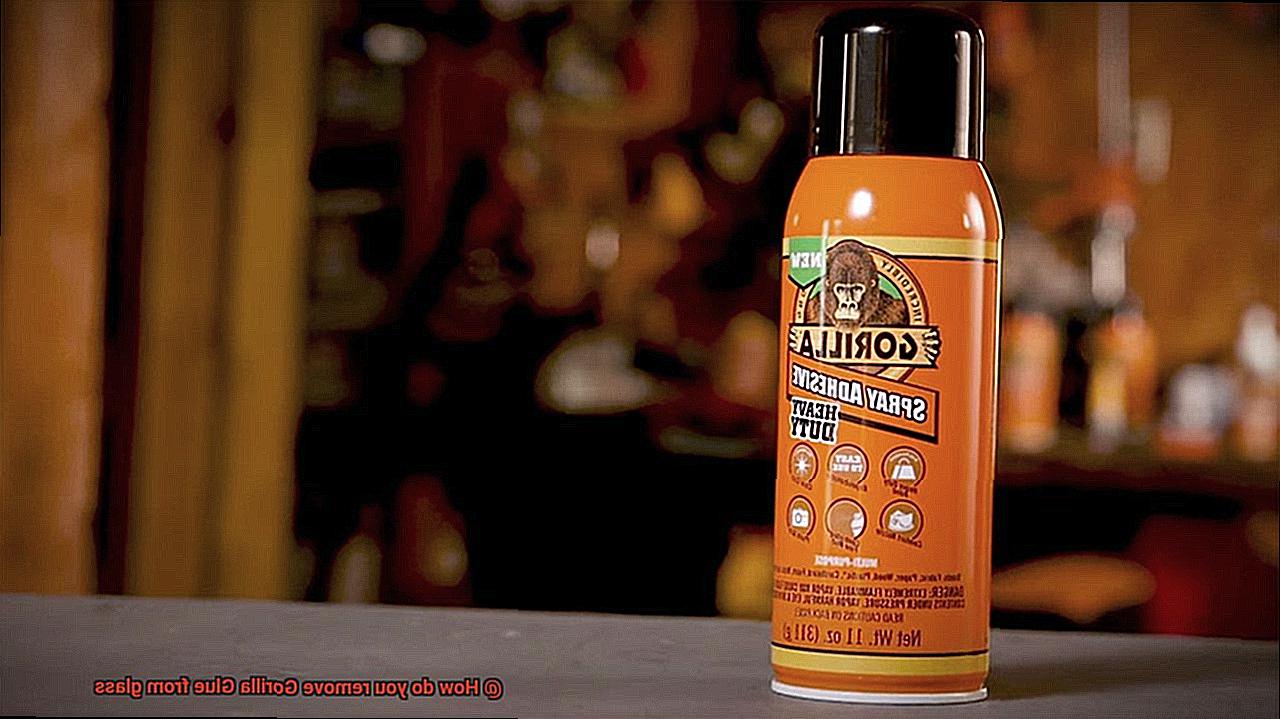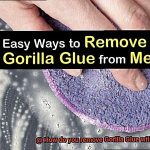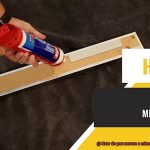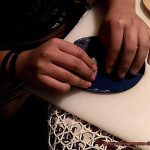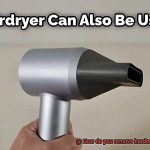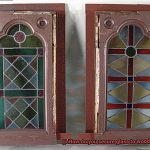We’ve all been there – the moment of panic when Gorilla Glue meets glass, leaving us with a sticky mess and a sinking feeling. But fear not, my fellow glass aficionados.
In this blog post, we’re going to tackle the challenge head-on and show you how to remove Gorilla Glue from glass surfaces without breaking a sweat (or your precious glass).
From gathering the necessary materials to step-by-step instructions, consider this your ultimate guide to bidding adieu to those stubborn glue remnants. So let’s dive in and reclaim our crystal-clear surfaces.
How do you remove Gorilla Glue from glass?
Contents
- 1 How do you remove Gorilla Glue from glass?
- 2 What is Gorilla Glue?
- 3 How Does Gorilla Glue Bond to Glass?
- 4 Heat Method for Removing Gorilla Glue from Glass
- 5 Acetone Method for Removing Gorilla Glue from Glass
- 6 Natural Methods for Removing Gorilla Glue from Glass
- 7 Scraping Method for Removing Gorilla Glue from Glass
- 8 Cleanup After Removal of Gorilla Glue from Glass
- 9 Conclusion
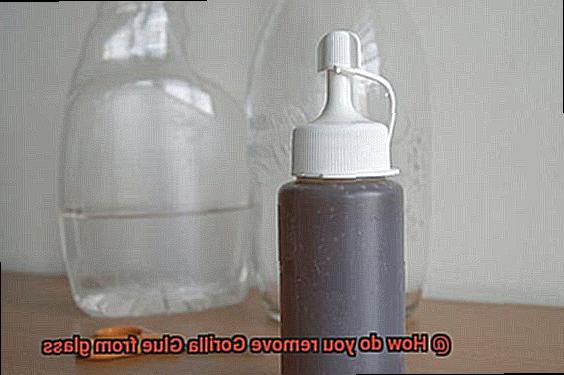
Step 1: Gathering the Materials
Before we embark on this quest, make sure you have your arsenal ready:
- Safety goggles (to protect those precious peepers)
- Disposable gloves (because safety first.)
- Isopropyl alcohol (preferably 91% concentration)
- Cotton swabs or balls (the trusty sidekicks)
- Plastic scraper or old credit card (for some gentle scraping action)
- Microfiber cloth (to polish your victory)
Step 2: Preparing for Removal
First things first – ensure your work area is well-ventilated. Then don your safety goggles and disposable gloves like a superhero suiting up for battle. Safety is key.
Step 3: Softening the Glue
Now it’s time to soften that pesky Gorilla Glue. Take a cotton swab or ball, soak it in isopropyl alcohol, and gently dab at the glue on the glass surface. Let the alcohol work its magic for a few minutes; it’ll loosen up that grip and make removal a breeze.
Step 4: Scrape and Swab
Grab your plastic scraper or old credit card and get ready for some precision scraping. Carefully scrape away the softened Gorilla Glue from the glass surface, making sure to keep the angle flat against the glass. We don’t want any accidental scratches here.
If you spot any stubborn remnants of glue, don’t fret. Dip a fresh cotton swab or ball into isopropyl alcohol and give those spots a gentle rub. This should help loosen up any tenacious residue.
Step 5: Wipe it Clean
Congratulations. You’ve successfully banished that Gorilla Glue from your glass surface. Now, grab that trusty microfiber cloth and wipe away any remaining traces of glue. Leave
What is Gorilla Glue?
Gorilla Glue is a polyurethane adhesive that is renowned for its exceptional strength and versatility. It is capable of bonding a wide range of materials, including glass, wood, metal, ceramic, and more. This powerful adhesive is waterproof and can withstand extreme temperatures and harsh environmental conditions.
What sets Gorilla Glue apart is its ability to expand when it comes into contact with moisture. This expansion helps create a strong bond by filling in gaps and creating a tight seal between the surfaces being bonded. However, this expansion can present challenges when removing the glue from glass surfaces.
When using Gorilla Glue, it is important to note that it dries to a light tan color and has a thick consistency. It is not suitable for temporary or removable applications, as once it bonds, it can be challenging to remove without causing damage.
Aside from its adhesive properties, Gorilla Glue is known for its high adhesive strength. It can withstand heavy loads, making it suitable for both indoor and outdoor use. The glue is resistant to water and chemicals, making it ideal for wet or humid environments.
Removing Gorilla Glue from glass surfaces requires special techniques and precautions. Heat can be applied using a hairdryer or heat gun to soften the glue, making it easier to scrape off. Acetone can also be used as a solvent to break down the adhesive bonds. However, caution must be exercised as acetone may damage certain types of glass. Natural alternatives such as vinegar or lemon juice can also be used to break down the glue.
In cases where the Gorilla Glue has hardened on the glass, a razor blade or glass scraper can be used to carefully scrape off the glue. Care must be taken to avoid scratching or damaging the glass.
After successfully removing the Gorilla Glue, it is advisable to clean the area thoroughly using mild soap and warm water to remove any residue.
How Does Gorilla Glue Bond to Glass?
Gorilla Glue is a remarkable adhesive that has gained popularity for its strong bonding power and versatility. It can effectively bond a wide range of materials, including glass. The secret behind its impressive bonding capabilities lies in a chemical reaction known as polyurethane cross-linking. This reaction occurs when the glue comes into contact with moisture, such as water or the humidity present in the air.
When Gorilla Glue is applied to glass, it undergoes a fascinating transformation. It starts to expand and foam up as it reacts with the moisture present on the surface. This expansion is advantageous because it allows the glue to seep into any pores or imperfections on the glass, creating a bond that is both strong and durable. The foaming action of Gorilla Glue also serves another purpose – it fills in any gaps between surfaces, providing additional strength to the bond. This makes it particularly useful when gluing glass pieces together or attaching glass to other materials.
The resulting bond created by Gorilla Glue is incredibly robust and resilient. It can withstand various environmental factors without losing its adhesive properties. Whether it’s temperature changes or exposure to moisture, Gorilla Glue remains steadfast, ensuring a long-lasting bond. Furthermore, this adhesive is resistant to impact and vibrations, making it perfect for bonding glass objects that may be subjected to stress or movement.
To maximize the effectiveness of Gorilla Glue when bonding glass, a few key steps should be followed. Firstly, it’s essential to moisten the glass surface slightly before applying the adhesive. This can be done by simply wiping the glass with a damp cloth or spritzing it with water. This provides the necessary moisture for the glue to initiate the bonding process successfully.
Additionally, applying pressure to the glued surfaces during the curing process can significantly enhance the strength of the bond. Clamping or using weights on the glued glass pieces helps achieve a secure attachment and ensures an even distribution of the adhesive.
However, removing Gorilla Glue from glass can be quite challenging due to its strong adhesive properties. Nevertheless, there are a few effective methods that can help loosen and remove the glue. One option is to soak the glued glass in warm, soapy water. This softens the glue, making it easier to peel or scrape off. Another alternative is using acetone, a powerful solvent that can break down the bond created by Gorilla Glue. Applying acetone to a cloth or cotton ball and rubbing it onto the glued area can gradually dissolve the adhesive. It’s important to test a small, inconspicuous area of the glass first to ensure that acetone doesn’t damage or discolor it.
In some instances, gentle heat can assist in removing Gorilla Glue from glass. By heating the glued area with a hairdryer or heat gun, the adhesive softens, making it easier to remove.
However, it’s crucial to handle all removal methods with care and avoid using sharp tools that could scratch or damage the glass surface. If you’re uncertain about the best removal method or if the glued glass is valuable or delicate, seeking professional assistance from a glass specialist or repair technician is highly recommended.
Heat Method for Removing Gorilla Glue from Glass
The heat method is a powerful solution for removing Gorilla Glue from glass surfaces. By utilizing heat, you can soften the stubborn adhesive, making it easier to scrape or peel off. Here’s a step-by-step guide on how to effectively use the heat method:
- Shield and Protect: Before you start applying heat, safeguard the surrounding area by placing a heat-resistant material like aluminum foil or a silicone mat underneath the glass surface. This will ensure that no damage occurs to the underlying surface.
- Apply Gentle Heat: Take a hairdryer or heat gun set on low heat and hold it a few inches away from the glue. Move it in a back-and-forth motion over the glued area for a few minutes. This allows the heat to evenly distribute without causing harm to the glass.
- Soften and Scrape: As the glue warms up, it will become more pliable and easier to remove. Utilize a plastic scraper or credit card to gently scrape off the softened glue from the glass surface. Be cautious not to scratch or damage the glass while doing so.
- Repeat if Necessary: In case there are stubborn remnants of glue left behind, reapply heat and continue scraping until every trace of Gorilla Glue has been eliminated.
- Cleanse and Rinse: After successfully removing the glue, cleanse the glass surface with warm soapy water to remove any residual residue.
It is crucial to remember that excessive heat can potentially harm certain types of glass, such as tempered or laminated glass. Prior to applying heat to the entire surface, always test a small, inconspicuous area first. Additionally, for your own safety, wear protective gloves and eyewear when using heat to prevent any accidental burns or injuries.
Acetone Method for Removing Gorilla Glue from Glass
The acetone method is a powerful tool in your arsenal against the stubborn grip of Gorilla Glue on glass surfaces. Acetone, a chemical solvent, comes to the rescue by effectively breaking down the adhesive properties of the glue, making it easier to remove. But before you dive into battle, ensure your safety by working in a well-ventilated area and donning gloves and eyewear.
To embark on this mission, gather your supplies: acetone, a sponge or cloth, and a plastic scraper or spatula. These tools will aid you in removing the glue without causing any harm to the glass.
Apply a small amount of acetone onto the glue residue, but exercise caution, for too much can damage the glass. Let the acetone sit for a few minutes, allowing it to penetrate and weaken the adhesive’s tight grip.
Armed with patience, wield your plastic scraper or spatula to gently scrape away the softened glue. Remember, gentle strokes are key to avoiding scratches on the glass surface. If some remnants persist, repeat the process by applying more acetone and patiently allowing it to work its magic before scraping it off.
Once victory is achieved and all traces of Gorilla Glue are banished from the glass surface, cleanse it with warm soapy water to remove any residue left behind by the acetone. This final step ensures that your glass is left pristine and free from any lingering signs of battle.
Bear in mind that acetone should only be used on glass surfaces and not on materials like plastic or wood, as it can cause damage. To be safe, always test a small inconspicuous area of the glass first to ensure no adverse effects arise.
Natural Methods for Removing Gorilla Glue from Glass
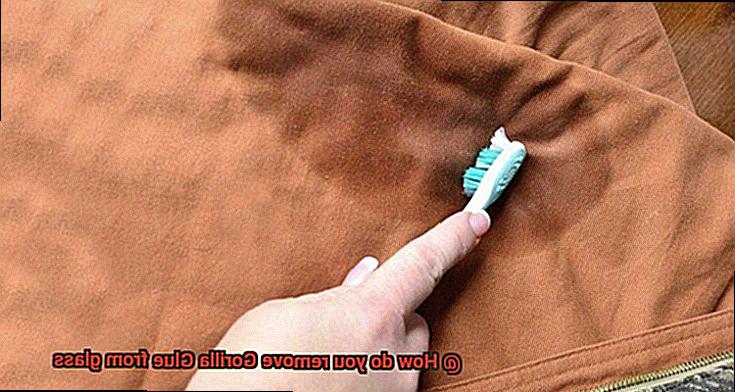
Natural methods for removing Gorilla Glue from glass offer effective and environmentally friendly alternatives to chemical solvents. Household items such as vinegar, baking soda, lemon juice, and rubbing alcohol can be utilized to dissolve the adhesive properties of the glue.
Vinegar, a mild acid, can be used by soaking a cloth or sponge and applying it to the glue stain. After allowing it to penetrate for a few minutes, gently scrub the area with a soft brush or cloth. Rinse the glass with warm water to remove any residue.
Baking soda, an alkaline substance, can also be effective. Mix equal parts baking soda and water to form a paste, which should be applied to the glue stain for approximately 15 minutes. Scrub the area with a soft brush or cloth, then rinse with warm water.
Lemon juice, with its acidic properties, can help break down the adhesive. Squeeze fresh lemon juice onto the glue stain and let it sit briefly before gently scrubbing. Rinse thoroughly with warm water.
Rubbing alcohol, if available, is another natural solvent option. Soak a cloth or sponge in rubbing alcohol and apply it to the glue stain. After allowing it to penetrate for a few minutes, gently scrub the area. Rinse with warm water.
For stubborn adhesive, heat can be employed. Use a hairdryer or heat gun on a low setting to gently warm the glue. Be cautious not to overheat the glass. Once softened, carefully scrape off the glue with a plastic scraper or fingernail, wiping away any residue with a damp cloth.
These natural methods may require patience and multiple attempts for fully cured glue stains. It is advisable to test these methods on a small, inconspicuous area of the glass before treating the entire stain.
Scraping Method for Removing Gorilla Glue from Glass
I am here to reveal the ultimate method for banishing Gorilla Glue from glass through the art of scraping. So, gather your tools and let’s embark on this adhesive eradication journey.
First and foremost, you’ll need a trusty scraping tool by your side. Options include a plastic scraper, a sharp-edged credit card, or even a razor blade. Just ensure that the chosen tool won’t harm or scratch the delicate glass surface.
Now, hold that scraping tool at a slight angle and delicately glide it along the glue-infested surface. Apply just enough pressure to vanquish the glue without causing any damage. Remember, patience is your ally here. Take your time and proceed with caution to avoid any unfortunate incidents.
If the glue proves to be a formidable foe, it’s time to unleash the power of heat. Grab your hairdryer and set it to a low heat setting. Direct the warm airflow towards the glue for a few minutes. The gentle warmth will bestow upon the adhesive a tender softness, rendering it susceptible to your scraping prowess.
As you triumphantly scrape away the glue, keep an eye out for any fragments or debris that may detach in the process. A damp cloth or paper towel shall serve as your loyal accomplice in wiping away this conquered residue. Thus, ensuring a pristine glass surface once all traces of glue have been obliterated.
Upon completing the scraping ritual, meticulously examine the glass for any lingering adhesive remnants. Should any stubborn spots catch your keen eye, fear not. Simply repeat the sacred scraping method until every last vestige of Gorilla Glue has been eradicated.
Having bid farewell to this tenacious adhesive, it is now time to grace your glass with a final touch-up. Employ a gentle glass cleaner or warm soapy water to cleanse away any remnants from the scraping process.
Remember, my dear reader, that scraping should only be employed on glass surfaces, as it may wreak havoc and inflict scratches upon other materials. Additionally, exercise utmost caution when handling sharp objects, ensuring they remain beyond the reach of curious children.
Cleanup After Removal of Gorilla Glue from Glass
Cleaning up after removing Gorilla Glue from glass requires a few key steps. First, you need to remove any excess glue that may still be present on the glass surface. Gently scrape it off using a plastic scraper or a credit card, being careful not to scratch or damage the glass.
Next, tackle any remaining residue by using acetone or nail polish remover. Apply a small amount of acetone to a cloth or cotton ball and gently rub it onto the glue residue. The acetone will help break down the glue, making it easier to remove. Work in a well-ventilated area and avoid getting acetone on your skin or in your eyes.
If you don’t have acetone or nail polish remover, isopropyl alcohol can be used as an alternative. Apply a small amount of alcohol to a cloth or cotton ball and gently rub it onto the glue residue. The alcohol will help dissolve the glue, making it easier to wipe away.
Another option is to use vinegar as a natural alternative for removing Gorilla Glue residue from glass. Soak a cloth or paper towel in vinegar and place it over the glue residue. Let it sit for a few minutes to allow the vinegar to penetrate the glue, then gently scrub the area with the cloth. The acidity of vinegar helps break down the glue, making it easier to remove.
After removing all traces of Gorilla Glue, give the glass a thorough cleaning with a glass cleaner or mild soap and water. This will help remove any remaining traces of adhesive or cleaning agents used in the removal process.
Finally, dry the glass thoroughly with a clean, lint-free cloth to prevent any water spots or streaks from forming. The glass should now be clean and free from any Gorilla Glue residue, ready to be used again.
5rLRekxJbco” >
Conclusion
In conclusion, removing Gorilla Glue from glass surfaces can feel like an uphill battle. But fear not. With the right tools and techniques at your disposal, you can conquer this sticky situation and restore your glass to its former glory.
There are several methods you can employ to tackle the glue. You could opt for the power of isopropyl alcohol, which softens the adhesive and makes it easier to remove. Or perhaps you prefer the heat approach, using a hairdryer or warm water to loosen Gorilla Glue’s grip on your precious glass.
If chemical solutions are more your style, acetone is a potent solvent that can dissolve the glue effectively. But if you’re looking for a natural alternative, vinegar or lemon juice might just do the trick. The choice is yours.
Remember, patience and caution are key throughout this process. Gather all necessary materials before diving in and don’t forget to protect yourself with safety goggles and gloves. Follow step-by-step instructions diligently to ensure success.
Softening the glue is just the first step. Gently scrape it off using a plastic scraper or an old credit card, being careful not to damage the glass surface. Once you’ve removed as much as possible, wipe away any residue with a trusty microfiber cloth.
It’s important to understand that Gorilla Glue forms a powerful bond with glass due to its polyurethane cross-linking reaction. This adhesive boasts exceptional strength and versatility but poses challenges when it comes time for removal. Handle all methods with care to avoid causing any harm to your beloved glass.
And if you find yourself unsure about which method is best or if your glued glass holds significant value or delicate qualities, don’t hesitate to seek professional assistance from a glass specialist or repair technician. They have the expertise needed to navigate this sticky situation safely.
By following these guidelines and taking your time during the removal process, victory over those stubborn Gorilla Glue remnants on your glass surfaces is within reach.

